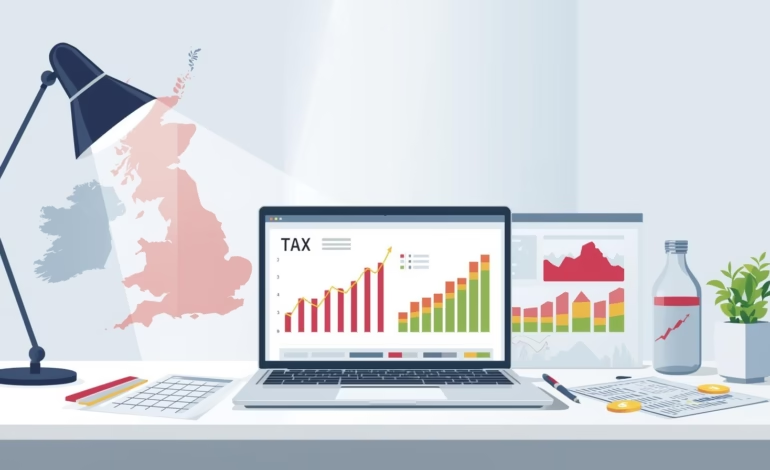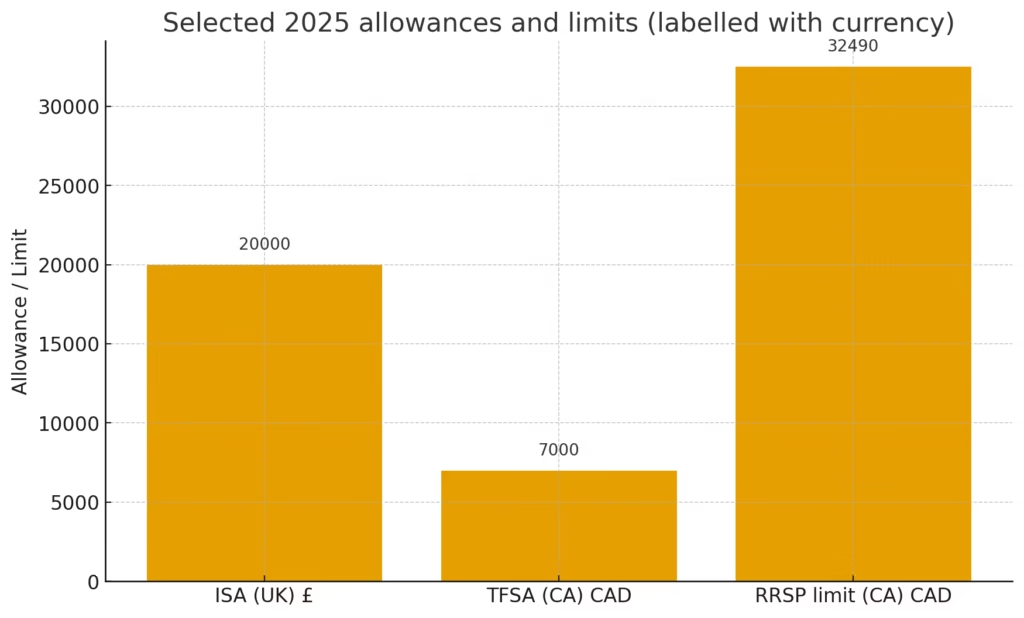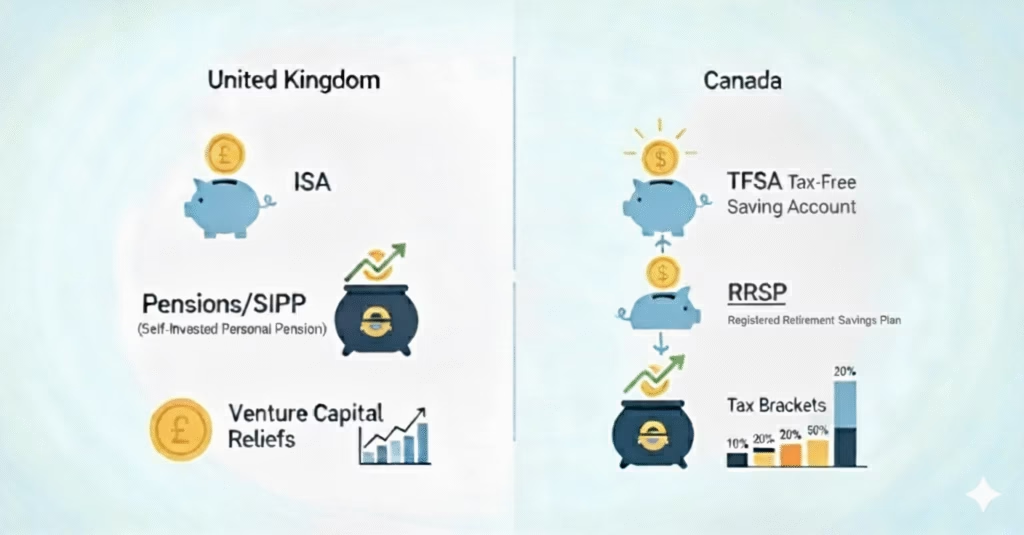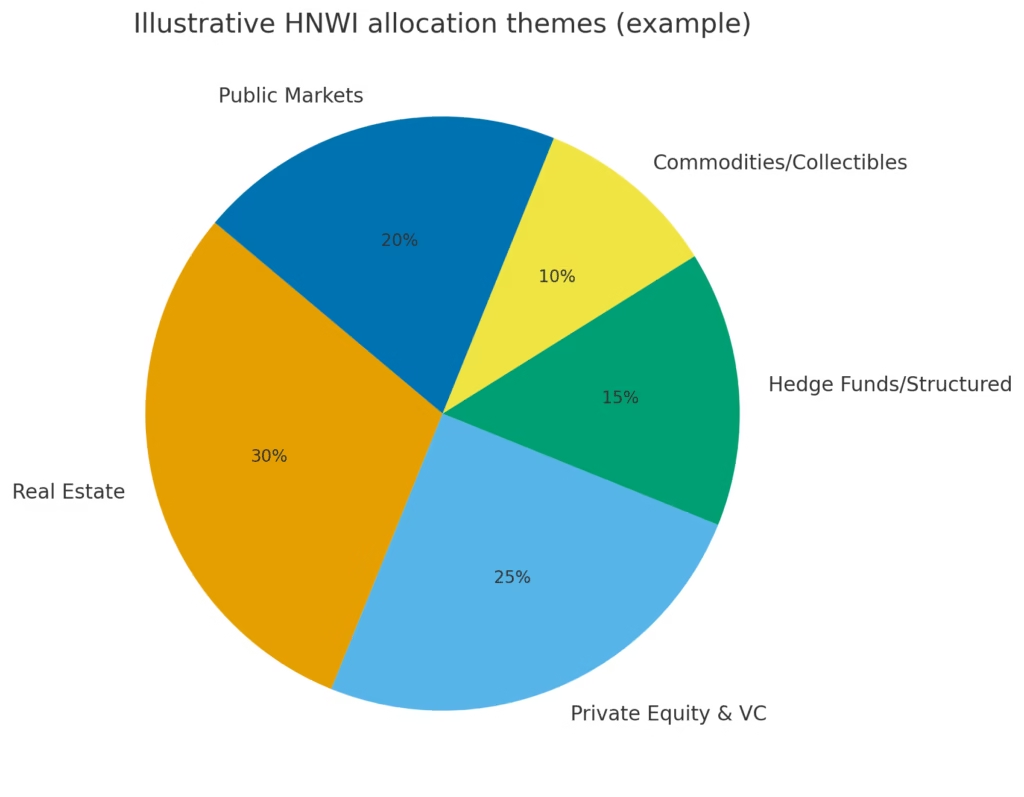
Best Tax-Saving Investment Options in the UK and Canada are essential for anyone looking to reduce their tax burden, especially in countries like the UK and Canada where higher income often means higher tax brackets. For years, I used to think about investments only in terms of returns, but experience has taught me that what you keep after tax is even more important than what you earn.
This blog is not theory from textbooks. It’s built on real conversations I’ve had with professionals, entrepreneurs, and families in both countries who have used tax-efficient investments to keep more of their money working for them. My goal is to make this simple, actionable, and something you can actually use in your financial life.
Why Tax Saving Investments Are Non-Negotiable
Every time I’ve worked with someone in the UK or Canada, the same issue comes up: taxes eat into income so fast that people feel like they are working for the government instead of themselves. In the UK, if you’re in the higher tax band, you might be paying 40 to 45 percent of your income. In Canada, depending on your province, your marginal tax rate can cross 50 percent.
If you are not planning your taxes, you are leaving thousands on the table every single year. For example, one of my Canadian clients was paying over CAD 35,000 in taxes more than necessary simply because they weren’t maximizing RRSP and TFSA contributions. Once we fixed that, the savings became an investment tool that grew year after year.
That’s the power of tax saving investments. They don’t just reduce today’s tax bill, they compound into long-term wealth.
Understanding the Basics of Tax Efficient Investing
Before diving into specifics, let’s simplify what tax saving actually means. In most developed countries, tax efficiency is achieved in three main ways:
- Deductions – Lowering your taxable income (like contributing to a pension in the UK or an RRSP in Canada).
- Exemptions – Earning income that is not taxed at all (like ISAs in the UK or TFSAs in Canada).
- Deferrals – Postponing taxes until later, ideally when you are in a lower tax bracket (common in retirement accounts).
The goal is to build a balanced portfolio that uses all three approaches. In practice, that means combining retirement contributions, tax-free growth accounts, and even charitable strategies.

Best Tax Saving Investment Options in the UK
Living and working in the UK gives you access to some of the most flexible tax wrappers in the world. Here are the top ones that I’ve seen professionals and high-net-worth individuals rely on:
Individual Savings Accounts (ISAs)
If there’s one account that almost every UK resident should use, it’s the ISA. Whether you prefer low-risk cash savings or want to invest in global markets through stocks and shares, the ISA makes sure all your growth is completely tax free.
The annual allowance is currently £20,000, and you can split this across different ISA types. Personally, I’ve seen most younger professionals lean towards Stocks and Shares ISAs because long-term equity growth sheltered from capital gains tax can make a huge difference.
Pensions and SIPPs
Pensions in the UK are incredibly powerful because of tax relief. Imagine you are in the 40 percent tax bracket. For every £600 you contribute, the government tops it up to £1,000. That’s like getting a guaranteed 66 percent return before you even invest.
Workplace pensions are great because employers also contribute. But if you want control, a Self-Invested Personal Pension (SIPP) gives you freedom to choose where your retirement savings go. I’ve personally seen clients use SIPPs to hold property, ETFs, and even international funds.
Venture Capital Reliefs
This is where the UK really stands out. Through schemes like EIS (Enterprise Investment Scheme), SEIS (Seed Enterprise Investment Scheme), and VCTs (Venture Capital Trusts), you can invest in startups and receive up to 30 percent income tax relief plus exemptions on capital gains.
Of course, these are high-risk investments, but I’ve seen entrepreneurs and wealthy families use them not just for tax planning but also to diversify into early-stage businesses.
Charitable Giving
One of the simplest yet overlooked strategies is Gift Aid. If you’re a higher rate taxpayer, donating £1,000 to charity can actually reduce your tax bill while increasing the charity’s benefit. Philanthropy here works both ways – impact and efficiency.
Best Tax Saving Investment Options in Canada
Canada’s tax structure is different but the principle is the same: the government rewards you for saving towards specific goals. Some of the best tax saving investment options I’ve seen Canadians use include:
RRSP (Registered Retirement Savings Plan)
The RRSP is like the Canadian cousin of the UK pension. Every dollar you contribute reduces your taxable income for the year. For example, if you earn CAD 100,000 and contribute CAD 20,000 to your RRSP, you are only taxed on CAD 80,000.
Your investments inside the RRSP grow tax deferred, and ideally you withdraw them in retirement when your income (and tax rate) is lower. It’s not just for retirement – RRSPs can also be used for the Home Buyers’ Plan and Lifelong Learning Plan, making them flexible.
TFSA (Tax Free Savings Account)
The TFSA is Canada’s version of the ISA. Any growth inside is completely tax free, and unlike the RRSP, withdrawals are also tax free. The contribution limit for 2025 is CAD 7,000, and unused room rolls forward.
Here’s a simple example: if you put CAD 7,000 annually into a TFSA and invest it in an S&P 500 index fund returning 8 percent, in 20 years you’ll have over CAD 320,000 – completely tax free. That’s the kind of compounding power Canadians can unlock.

Alternative Investments: The Secret Weapons of HNWIs
For most high-net-worth individuals (HNWIs), traditional assets like stocks and bonds are only the foundation. The real wealth expansion comes from alternative investments that go beyond what the average investor considers. These vehicles provide diversification, higher returns, and often reduced exposure to public market volatility.
1. Real Estate Beyond the Obvious
Real estate is a staple for HNWIs, but not just residential apartments or commercial shops. They branch into:
- Luxury vacation rentals in high-demand tourist destinations (earning both appreciation and rental income).
- Commercial real estate funds that pool money into office spaces, warehouses, or retail properties.
- Global real estate holdings that hedge currency risks and create global cash flow.
For example, instead of owning a single property, HNWIs may invest in a Real Estate Investment Trust (REIT) or fractional ownership platforms, giving them exposure to large, diversified property portfolios.
2. Private Equity & Venture Capital
This is where wealthy investors play long games:
- Private equity allows them to buy into established but undervalued companies, restructure operations, and sell at a profit.
- Venture capital helps them fund high-growth startups (think early-stage investments in companies like Uber or Airbnb).
While risky, even a few successful exits can multiply wealth dramatically. Unlike public markets, these investments are less correlated with stock downturns, making them a strategic hedge.
3. Hedge Funds & Structured Products
Hedge funds remain attractive because they use advanced strategies (like shorting, derivatives, or global arbitrage) unavailable to most retail investors. The key advantage? Hedge funds aim for absolute returns regardless of market direction.
Similarly, structured products like collateralized debt, convertible bonds, or market-linked notes allow wealthy investors to design payoffs tailored to their risk appetite.
4. Commodities & Collectibles
To protect against inflation and diversify away from fiat currency risks, HNWIs turn to:
- Gold, silver, and rare metals (often in physical and ETF form).
- Luxury collectibles like fine art, vintage wines, rare watches, and even NFTs.
For example, an ultra-rare Rolex or a Picasso painting can appreciate faster than real estate in certain cycles, while also serving as a status asset.
5. Global Diversification
HNWIs rarely confine themselves to one country. Instead, they spread investments across currencies, stock exchanges, and jurisdictions. This approach not only hedges against geopolitical risks but also opens doors to emerging market growth.
An Indian HNWI might hold U.S. tech stocks, European bonds, and Singapore real estate all at the same time. This ensures that no single market crash wipes out their net worth.

Risk Management, Lifestyle Assets and Lessons for Retail Investors
So far, we have seen how HNWIs spread wealth across traditional and alternative assets. But what truly keeps them ahead is not just where they invest it is how they manage risk and align investments with lifestyle goals.
1. Risk Management as a Core Strategy
Wealthy investors never assume that markets will always rise. Instead, they:
- Use asset allocation models to balance risky and safe bets
- Hedge portfolios with options, futures, and commodities
- Diversify liquidity levels, some assets are highly liquid such as stocks and ETFs, while others such as real estate or private equity funds are locked for years
This balance ensures that even during market downturns, they do not scramble for cash. Liquidity is king when opportunities or emergencies strike.
2. Lifestyle Assets: Enjoyment Meets Growth
Unlike retail investors, HNWIs often buy assets that add to their lifestyle while appreciating in value. Examples include:
- A holiday villa in Bali or Tuscany that doubles as both a family retreat and a rental income source
- Classic cars, yachts, or art collections, items that showcase status while quietly building wealth
- Second passports or residency programs via investment in certain countries that provide mobility and security
These assets may seem indulgent but often turn out to be strategic wealth moves.
3. Philanthropy and Impact Investing
For many HNWIs, legacy matters as much as profits. Increasingly, they:
- Put money into impact funds that support renewable energy, healthcare, and education
- Use family foundations or trusts to ensure wealth outlives them
- Gain tax benefits while shaping industries aligned with personal values
This mindset not only protects wealth but amplifies influence across generations.
4. Lessons for Retail Investors
Not everyone can pour millions into art or private equity, but the principles behind HNWI strategies are accessible to anyone.
- Diversify, do not rely on one income source or one asset class
- Think global, ETFs and mutual funds provide international exposure affordably
- Balance liquidity, have emergency funds while still building long-term assets
- Start small but consistent, even a small SIP monthly compounds massively over 15 to 20 years
Curious how your money could grow over time? Try our SIP Calculator to project your future wealth.”
My Final Thoughts
High-net-worth individuals do not get richer by luck alone. They follow disciplined, diversified, and forward-thinking strategies that anyone, even you, can adapt at your own scale. The sooner you start thinking like an HNWI, the faster your wealth-building journey compounds.



